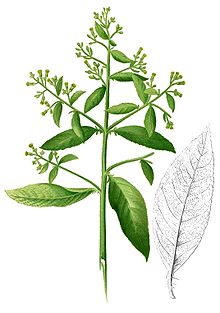|
Blumea
Blumea is a genus of flowering plants of the family Asteraceae.[3] CharacteristicsGenus Blumea is found in the tropical and sub-tropical zones of Asia, especially the Indian Subcontinent and Southeast Asia. A few species are found in Australia and still fewer in Africa.[2][4] The plants of this genus are mostly relatively small weeds.[5] Some of them are ruderal species. A few of the species were formerly included in genus Conyza. Many species of genus Blumea are used in traditional Chinese medicine. Other uses include as decorative dry plants. Blumea balsamifera (Nat; หนาด) is reputed to ward off spirits in Thai folklore, and is used in Philippines herbal medicine as well. Blumea axillaris (syn. Blumea mollis) leaf essential oil contains linalool (c. 19%), γ-elemene (c. 12%), copaene (c. 11%), estragole (c.11%), allo-ocimene (c. 10%), γ-terpinene (8%) and allo-aromadendrene (c. 7%). The essential oil had significant toxic effect against early fourth-instar larvae of Culex quinquefasciatus with LC50 = 71.71 and LC90 = 143.41 ppm.[6] Other uses of the nameBlumea is also the name of the Journal of Plant Taxonomy and Plant Geography published by the National Herbarium of the Netherlands.[7] SpeciesAs of December 2020[update], Plants of the World Online accepted the following species:[3]
Bibliography
References
External links
|
||||||||||||||||||||||||||||||||||||
